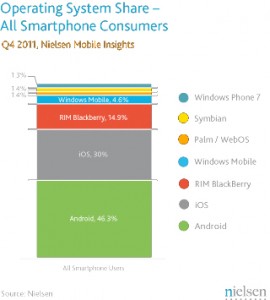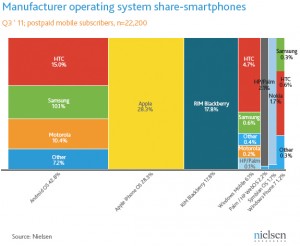Have you ever been engaged in conversation when talk turns to mobile? You hold your own by sharing all the improvements you’d make to Words with Friends (WWF) on your iPhone, but when things progress beyond a certain point, your eyes glaze over, your smile tightens in discomfort and you excuse yourself to check an “urgent incoming email.”
We’re not stupid, but let’s face it: we could probably use a primer on mobile vernacular. The mobile arena is growing by leaps and bounds and the lingo is dizzying. When I first heard the term “hot spot,” my mind went in a completely different direction, which makes me feel a bit like my grandmother did when I tried to explain electronic mail to her.
The main reason for the confusion is that there are a lot of components that make up mobile. They all intersect and each one has several players. We’re only going to scratch the surface today, but hopefully this rudimentary explanation will keep you from feeling awkward at your next power lunch.
At the risk of insulting your intelligence and revealing my ignorance, I’m sharing my primer on mobile terminology.
Mobile access points include cellular, wi-fi and hot spots. Many of the same devices can gain mobile entry using any of these access points. To keep things as simple as possible, I’ll be focusing on cellular.
Do you know the difference between Droid and Android? Droid is a brand of phone made by Motorola that runs on the Android platform and is available through Verizon. As consumers, we naturally identify with our devices, but metrics around mobile take into consideration the operating systems.
In the US, there are four major players* in the world of mobile operating platforms: Android, iOS, RIM and Windows, each of which is proprietary to its corporation. The company names will probably sound a bit more familiar.
- Android is Google’s operating system (OS).
- iOS is Apple’s OS.
- RIM is Blackberry’s OS.
- Windows Mobile is Microsoft’s OS.
*-Other OS’s include Palm / Web OS and Symbian.
Here’s a handy visual of the market share for each of these operating systems:
Note: This truly is only part of the picture. For the full data, visit the Nielsen blog.
Each operating system, which is built on a different source system (such as open-source Linux for Android or Darwin for iOS), boasts different feature sets. Each OS also has different source specifications, so apps available for one device may not be available for another. Some developers will work across several platforms, so for example you can play WWF on Android and iOS devices. Sorry, Blackberry users.
As such, each platform has its own app market as follows:
- Android (Google) has the Android Market.
- iOS (Apple) has the App Store.
- RIM (Blackberry) has AppWorld.
- Windows (Microsoft) has the Zune store.
OK, so we’ve got four main operating systems run by four major corporations with four marketplaces of available apps. Now, we want devices to go with them so we’ve got something to put in your (the consumers’) hands.
Different manufacturers make devices that run on these platforms. In some cases, multiple manufacturers make devices for the same platform. Manufacturers may also make different devices for multiple platforms.
- Manufacturers for Android (Google) devices include: HTC, LG, Samsung, Motorola, Sony, Dell.
- The only manufacturer for iOS devices is Apple.
- The only manufacturer for RIM devices is Blackberry.
- Manufacturers for Windows (Microsoft) devices include: HTC, Dell, LG, Samsung, Nokia.
Here is a handy chart showing the operating system market share by manufacturer:
For the full Nielsen article, visit their blog.
So you’ve got a nifty device with the native features of its operating system and all the extra goodies from developers programming apps for it. Now you need a cellular service, assuming you are not accessing solely via wi-fi or hot spots.
There are nearly 200 carriers (aka wireless communications service providers) in the US, including AT&T, Sprint, T-Mobile and Verizon. Since these are the major four, we’ll focus on them. Each provider supports devices running on select platforms.
- AT&T supports devices running Android (Google), iOS (Apple), RIM (Blackberry) and Windows (Microsoft) plus Palm/ Web OS and Symbian.
- Sprint supports devices running Android (Google), iOS (Apple), RIM (Blackberry) and Windows (Microsoft).
- T-Mobile supports devices running Android (Google), RIM (Blackberry) and Windows (Microsoft).
- Verizon supports devices running Android (Google), iOS (Apple), RIM (Blackberry), Windows (by Microsoft) plus Palm / Web OS.
We naturally identify with our devices because they are the tangible manifestation of all of the background stuff: the operating system (which will determine the basic system features), the brand recognition (are you a Mac or PC kind of person?) and all of the whistles and bells (the available applications for that device). But then you also have your cellular provider to think about. Not only who offers the best rates, but who offers the best rates for the device you want?
Enter unlocking. This one’s for extra credit. Many T-Mobile customers have iPhone-envy because T-Mobile is the only provider of the big four that doesn’t have a deal for iOS devices. However, this does not mean T-Mobile customers can’t have iPhones. Users can purchase “unlocked” iPhones directly from Apple that will work on T-Mobile’s network with modified SIM cards. However, the network is not optimized for the platform, so iPhones being used on T-Mobile will run more slowly.
And 3G and 4G networks? The G stands for Generation. Each generation is simply a faster, more reliable iteration of the carrier’s network.
So the next time you’ve used up your witty WWF repartee and the mobile talk continues, there’s no reason to run back to the buffet from shame. Chances are you’ve got a better sense of what all that jargon means than the next person. So look for that poor soul with glazed eyes and tightened grin, pull him aside and lay out the basics.






{ 1 trackback }